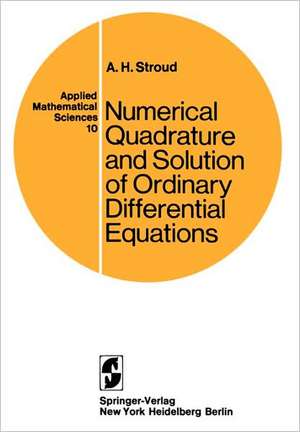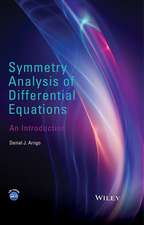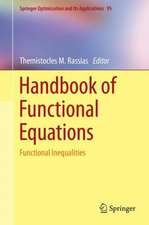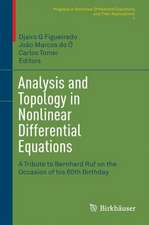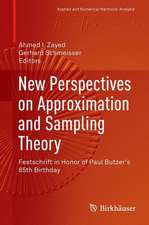Numerical Quadrature and Solution of Ordinary Differential Equations: A Textbook for a Beginning Course in Numerical Analysis: Applied Mathematical Sciences, cartea 10
Autor A.H. Strouden Limba Engleză Paperback – 26 iul 1974
Din seria Applied Mathematical Sciences
- 13%
 Preț: 426.94 lei
Preț: 426.94 lei - 13%
 Preț: 426.46 lei
Preț: 426.46 lei - 13%
 Preț: 427.63 lei
Preț: 427.63 lei - 9%
 Preț: 1728.59 lei
Preț: 1728.59 lei - 24%
 Preț: 906.80 lei
Preț: 906.80 lei - 23%
 Preț: 659.07 lei
Preț: 659.07 lei -
 Preț: 375.65 lei
Preț: 375.65 lei - 18%
 Preț: 909.47 lei
Preț: 909.47 lei - 18%
 Preț: 795.02 lei
Preț: 795.02 lei - 18%
 Preț: 950.52 lei
Preț: 950.52 lei - 15%
 Preț: 645.47 lei
Preț: 645.47 lei - 20%
 Preț: 755.49 lei
Preț: 755.49 lei -
 Preț: 382.67 lei
Preț: 382.67 lei - 24%
 Preț: 808.06 lei
Preț: 808.06 lei -
 Preț: 452.62 lei
Preț: 452.62 lei -
 Preț: 399.12 lei
Preț: 399.12 lei - 18%
 Preț: 966.90 lei
Preț: 966.90 lei - 15%
 Preț: 643.48 lei
Preț: 643.48 lei - 15%
 Preț: 528.80 lei
Preț: 528.80 lei -
 Preț: 413.15 lei
Preț: 413.15 lei -
 Preț: 390.25 lei
Preț: 390.25 lei - 18%
 Preț: 736.01 lei
Preț: 736.01 lei - 18%
 Preț: 1411.05 lei
Preț: 1411.05 lei - 15%
 Preț: 711.21 lei
Preț: 711.21 lei -
 Preț: 395.47 lei
Preț: 395.47 lei - 18%
 Preț: 1017.26 lei
Preț: 1017.26 lei -
 Preț: 403.15 lei
Preț: 403.15 lei - 18%
 Preț: 1130.14 lei
Preț: 1130.14 lei - 18%
 Preț: 1134.87 lei
Preț: 1134.87 lei - 18%
 Preț: 1329.00 lei
Preț: 1329.00 lei - 18%
 Preț: 1129.65 lei
Preț: 1129.65 lei - 18%
 Preț: 1140.71 lei
Preț: 1140.71 lei
Preț: 190.23 lei
Nou
Puncte Express: 285
Preț estimativ în valută:
36.41€ • 39.56$ • 30.61£
36.41€ • 39.56$ • 30.61£
Carte tipărită la comandă
Livrare economică 22 aprilie-06 mai
Preluare comenzi: 021 569.72.76
Specificații
ISBN-13: 9780387901008
ISBN-10: 0387901000
Pagini: 338
Ilustrații: XI, 338 p.
Dimensiuni: 168 x 240 x 19 mm
Greutate: 0.57 kg
Ediția:Softcover reprint of the original 1st ed. 1974
Editura: Springer
Colecția Springer
Seria Applied Mathematical Sciences
Locul publicării:New York, NY, United States
ISBN-10: 0387901000
Pagini: 338
Ilustrații: XI, 338 p.
Dimensiuni: 168 x 240 x 19 mm
Greutate: 0.57 kg
Ediția:Softcover reprint of the original 1st ed. 1974
Editura: Springer
Colecția Springer
Seria Applied Mathematical Sciences
Locul publicării:New York, NY, United States
Public țintă
GraduateCuprins
1 Background Information.- 1.1 Significant figures and round-off error.- 1.2 Computers and floating-point arithmetic.- 1.3 Complex numbers.- 1.4 Inequalities for numbers.- 1.5 Convergence of a sequence of numbers.- 1.6 Polynomials and their roots.- 1.7 Systems of linear equations.- 1.8 The Vandermonde matrix.- 1.9 Continuous functions; piecewise continuous functions.- 1.10 Mean value theorem and Rolle’s theorem.- 1.11 Convergence of a sequence of functions.- 1.12 The chain rule for derivatives.- 1.13 Definite integrals and Riemann sums.- 1.14 Linear transformation of one interval onto another.- 1.15 Change of variables in an integral.- 1.16 Mean value theorem for integrals.- 1.17 Inequalities for integrals.- 1.18 The class of functions Wm[Mm; a,b].- 1.19 The function (x - t)+k.- 1.20 Taylor’s formula with integral form of remainder.- 1.21 Taylor’s formula with usual form of remainder.- 1.22 Taylor’s formula for functions of two variables.- 1.23 Difference equations.- 1.24 Linear difference equations with constant coefficients.- 1.25 Linear functional.- 1.26 Tri-diagonal linear systems.- References for Chapter 1.- 2 Interpolation.- 2.1 Existence of interpolating polynomials.- 2.2 Construction of the interpolating polynomial by solution of a linear system.- 2.3 One form for the error in the interpolation.- 2.4 Convergence of a sequence of interpolations.- 2.5 The Weierstrass approximation theorem.- 2.6 Iterated interpolation.- 2.7 Peano estimates for the error in interpolation.- 2.8 Interpolation by rational functions.- 2.9 Interpolation by cubic spline functions.- 2.10 Additional reading.- References for Chapter 2.- 3 Quadrature.- 3.1 Introductory remarks and definitions.- 3.2 Existence of formulas exact for polynomials.- 3.3 Newton-Cotes formulas and theirproperties.- 3.4 Linear transformations of formulas.- 3.5 Repeated trapezoidal formula; repeated midpoint formula; repeated Simpson’s formula.- 3.6 Introduction to Gauss formulas.- 3.7 Orthogonal polynomials and their zeros.- 3.8 Existence of Gauss formulas.- 3.9 Convergence of a sequence of Gauss formulas for a continuous integrand.- 3.10 Introduction to Romberg formulas.- 3.11 Romberg formulas and their properties.- 3.12 Peano error estimates for quadrature formulas.- 3.13 Gauss-Legendre formulas are Riemann sums.- 3.14 The merits of Gauss-Legendre formulas.- 3.15 Formulas exact for trigonometric polynomials.- 3.16 Numerical integration by rational extrapolation.- 3.17 Numerical integration by cubic splines.- 3.18 Additional reading.- References for Chapter 3.- 4 Initial Value Problems for Ordinary Differential Equations.- 4.1 Introduction.- 4.2 Taylor’s series methods.- 4.3 Convergence of Taylor’s series methods.- 4.4 Runge-Kutta methods.- 4.5 Derivation of Runge-Kutta methods.- 4.6 The need for automatic choice of stepsize; the earth-moon-spaceship problem.- 4.7 Runge-Kutta methods with automatic choice of stepsize; methods of Zonneveld.- 4.8 Explicit multistep methods or predictor methods.- 4.9 Implicit multistep methods or corrector methods.- 4.10 Practical use of corrector methods; predictor-corrector methods.- 4.11 Stability of multistep methods for y’ = ?y.- 4.12 Stability of multistep methods for general equations.- 4.13 A method based on the midpoint formula and rational extrapolation.- 4.14 Additional reading.- References for Chapter 4.- Appendix A Tables of Orthogonal Polynomials.- Appendix B Tables of Peano Error Constants for Various Quadrature Formulas.- Appendix C Tables of Quadrature Formulas.- Index of Symbols.
